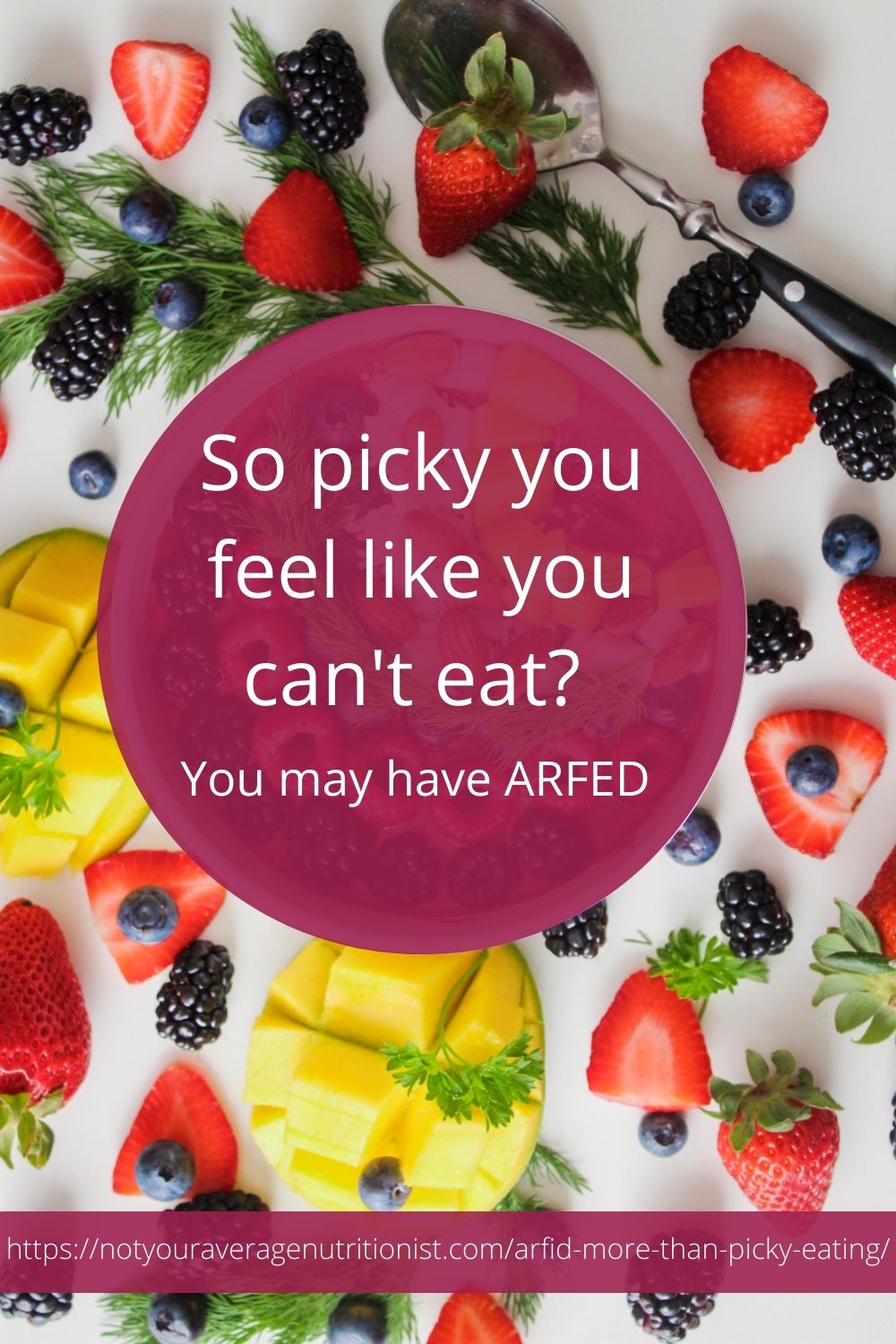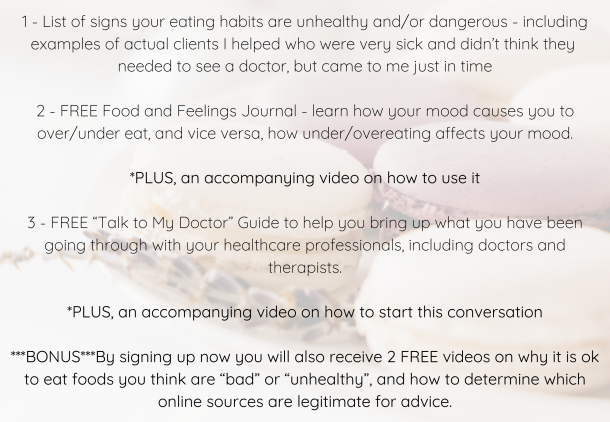By Abby Caudle-Patton
Abby is a second-year master’s student in Nutrition and Dietetics at Meredith College in Raleigh, NC. Abby currently works at a recovery center and enjoys reading, trying new recipes, exploring local trails, and snuggling with her pups.
ARFID – More Than Picky Eating
Eating disorders (ED) come in many shapes and sizes and are not all related to body image or appearance. Avoidant Restrictive Food Intake Disorder (ARFID) is a common eating disorder in childhood and adolescence that may continue into adulthood. (1)
ARFID may not be as well known as other EDs; however, it is estimated that just over 3% of the general population may meet diagnostic criteria for this disorder.(1)
But what is ARFID really?
Picture this –
You are sitting in a room full of friends sitting over a warm meal. Everyone is laughing, reminiscing about good times, and complementing the chef’s abilities to prepare such a satisfying entree. But you? You can’t stop thinking about the food on your plate. You aren’t thinking of it in the way your friends are – as delicious food that brings satisfaction and joy to the moment. You aren’t savoring the flavors and complementary textures. Unlike the others, you can wait for your next bite. In fact, you may be totally okay with not even taking the first bite. Instead of the food being a part of this fellowship, it is the only thing holding your focus. In reality, you wish it would simply disappear.
No, no. Your mind is not preoccupied with nutrition facts or other diet-culture-influenced thoughts. You aren’t tracking numbers in your head. Instead, you may be feeling genuine fear of the food. Maybe, the dish in front of you brings back traumatic memories of a choking experience. Maybe there was a time in your past that a similar food caused illness, and now nothing seems safe to eat. Maybe the sensation of crunchy food is too loud or smooth textures evoke negative feelings. Your friends joke that you are “so picky.” This has been the case for a while. In reality, they have no idea the loud ED thoughts that are constantly telling you that the food is too _____ (fill in the blank with whatever undesirable description resonates). Your food restriction simply is linked to the food and nothing else.
Just as no two individuals suffering from Anorexia Nervosa or Bulimia Nervosa experience their disorder the same, ARFID may look different from person to person. Similar to other restrictive eating disorders, such as anorexia, an individual with ARFID may have inadequate intake and therefore suffer the negative consequences of malnutrition including poor nutritional deficiencies, poor mobility and strength, bone mass loss, and organ damage.(2)
ARFID includes food rigidity or rules around intake that results in avoiding certain foods, food types, or food groups altogether.(3)
Many may label this as “picky eating to the maximum extent.” However, these finicky food patterns may be based on insufficient or inaccurate nutrition knowledge and beliefs, extreme aversions to tastes, smells, and textures, or traumatic events related to foods (ie: previous illness, coking, etc).(3)
For example, one may strictly avoid all foods containing gluten without a diagnosis of gluten intolerance or Celiac disease. This avoidance may be rooted in the belief that gluten causes illness to the individual when, in reality, this perceived illness stems from anxiety and intrusive, inaccurate ED thoughts telling the individual that the foods are “unsafe.”
Someone else may only eat one brand of frozen chicken nuggets and may push away all other types due to differences in texture or flavor. The X brand always looks, smells, and tastes the same. There are no surprises, and this food is always safe.

In summary, signs and symptoms of ARFID may include: (1)
- Lab tests that suggest malnutrition such as vitamin and mineral deficiencies
- Failure to meet growth standards in children and adolescents and unintended weight loss in adults
- Inability to participate in “normal” activities including social functions due to intrusive thoughts/anxieties surrounding food
- Limited variety of intake due to many foods being “unsafe” to the individual not associated with body image distress
- Acute anxiety in the presence of certain foods
- Aversions to specific food flavors, smells, and textures
Individuals with ARFID may benefit from accumulating positive experiences in the presence of fear foods. (4)
An activity that may be helpful to explore the fear food is to play with the food. I’m serious! It may sound silly but accumulating positive moments in the presence of foods, that typically induce anxiety, is really important. Any time we push ourselves to interact with the thing causing the anxiety, we tell our brains that we are safe and are going to be okay.
So, grab a bowl or plate of a fear food and a spoon. Lift the food on the utensil and explore it with all senses except for taste.
- What do you hear when you press the food with the back of the utensil? Does it make a sound when you pick it up? Can you compare the sound to something you enjoy (ie: potato chips may sound like leaves crunching under your feet during the fall time)
- What does it smell like? Is there a similar smell that you can compare it to?
- What does it look like? What textures and colors do you see? Is it shiny or dull? Are there holes or fibrous textures? Can you think of a color that is similar to this food? Where else does this color appear?
- Can you touch the food? Is it warm to the touch or is it cold? Smooth? Soft? Hard edges?
After doing this, take some time to journal your experience.
- What was your anxiety level before interacting with the food? What is it like now?
- What surprised you?
- Was there anything that previously evoked fear that now does not?
- What is a good goal for the next time you encounter the food?
- What would it be like to explore the food with the 5th sense – taste? What would it take to make this happen?
- Do you need a trusted sense of support to be there with you also consuming the food?
Make a plan – let’s keep working towards food acceptance!
All individuals suffering from an eating disorder deserve and are worthy of recovery. If you or a loved one is struggling with disordered eating behaviors, such as limited variety in dietary intake or ARFID, visit The Alliance for Eating Disorders Awareness to take the first step in getting help.


- ARFID – Avoidant/Restrictive Food Intake Disorder. Walden Eating Disorders. https://www.waldeneatingdisorders.com/what-we-treat/arfid/. Published September 3, 2020. Accessed October 21, 2020.
- 10 Effects of Malnutrition That Go Beyond Under-Nourishment. NCOA. https://www.ncoa.org/healthy-aging/chronic-disease/nutrition-chronic-conditions/why-malnutrition-matters/10-ways-malnutrition-impact-your-health-6-steps-prevention/. Published August 28, 2017. Accessed October 21, 2020.
- Avoidant Restrictive Food Intake Disorder DSM-5 307.59. Theravive Counseling. https://www.theravive.com/therapedia/avoidant-restrictive-food-intake-disorder-dsm–5-307.59. Accessed October 21, 2020.
- ARFID Treatment Options – Center For Discovery. Center For Discovery. https://centerfordiscovery.com/blog/afrid-treatment-options-summary/#:~:text=Exposure%20therapy%20for%20ARFID&text=Exposure%20therapy%20involves%20%E2%80%9Cexposing%E2%80%9D%20the,fearful%20to%20most%20anxiety%20provoking. Published 2020. Accessed December 30, 2020.


